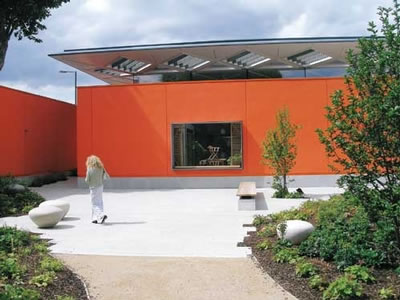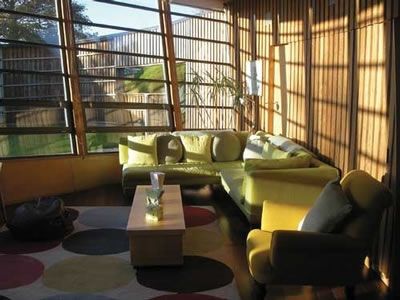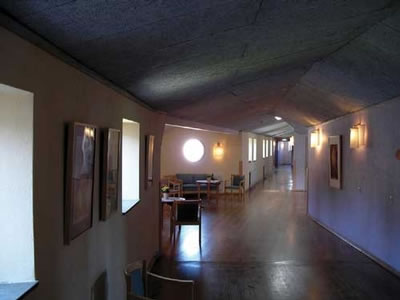 The surprise winner of the 2009 Stirling Prize for Architecture – Maggie’s Cancer Care Centre in London, designed by Rogers Stirk Harbour + Partners – strikes a blow for the revival of humanism in architecture.
The surprise winner of the 2009 Stirling Prize for Architecture – Maggie’s Cancer Care Centre in London, designed by Rogers Stirk Harbour + Partners – strikes a blow for the revival of humanism in architecture.
Initially a Scottish initiative – the first five Maggie’s Cancer Centres were in Edinburgh, Glasgow, Dundee, Inverness and Fife – the model is now being adopted across the UK and beyond. It represents a new wave of architectural idealism evoking that of an earlier generation of architects such as Alvar Aalto, Berthold Lubetkin and Aldo van Eyck. “Architecture should defend man at his weakest,” Aalto once wrote, and Maggie’s Centres respond directly to that injunction.
Their inventive, free style has helped bring public and critical attention to what is now known as “end of life” architecture, and consolidates the achievements of the well-established hospice movement in Britain. Both initiatives are a response to the grim conditions in which many elderly people still die in hospitals – not just in the refurbished Victorian workhouses, but even in some of the giant modern hospitals, recently described as “built catastrophes” by Dutch architect Cor Wagenaar. Over half of all current NHS complaints relate to the treatment of the dying in public hospitals where the elderly are treated as second-class citizens – or “clandestine beings” in the words of architect Stephen Verderber – and clinical staff regard death as an embarrassment. (It’s not what hospitals are for, they say.)
This is changing. The “right to a good death” has suddenly emerged as a matter of public debate, whether on Radio 4, in the pages of the Daily Telegraph or in celebrity magazines charting the final days of Jade Goody. There is now even a Parliamentary Sub-Committee on Dying Well. This extraordinary shift of attention recalls an earlier period in the rise of the welfare state, when architecture and humanism joined together in designing the structures of public health and well-being. In doing so this political energy produced many of the most valued buildings in the modern townscape – nursery schools, clinics, health centres, libraries and sports halls. The hospice has now joined that list.
Sheila Payne, Britain’s first professor of hospice studies, at Lancaster University, draws the analogy between providing the optimum conditions for a successful birth – a key aspiration of those pioneering times – and offering similar provision at the other end of life today. “What I’d like to see is the sort of approach you have in maternity services,” she has said. “There, women make birth plans but sometimes labour doesn’t go to plan. People find it’s all too painful and messy, so obstetric units have learnt to be flexible. I think that’s what needs to be possible in our model.” The model that Payne refers to is that of the modern hospice, though it also brings to mind the traditional role of the midwife, whose work included laying out and washing the dead (as any reader of DH Lawrence will know).
 The suggestion that dying might be prepared for – and to a degree planned – steps tentatively into the minefield of debate about the many shades of “managed” or “assisted” dying. One of the central issues in all this discussion is the place in which death finally occurs. It cannot always be at home, much as people profess to prefer it, but nor should it be in a hotel room abroad, one step ahead of the border officials or police.
The suggestion that dying might be prepared for – and to a degree planned – steps tentatively into the minefield of debate about the many shades of “managed” or “assisted” dying. One of the central issues in all this discussion is the place in which death finally occurs. It cannot always be at home, much as people profess to prefer it, but nor should it be in a hotel room abroad, one step ahead of the border officials or police.
Visiting hospices in Denmark and Sweden I was surprised to find that until very recently the Scandinavians were even more reticent than us in discussing the subject. An architect in Copenhagen told me that when the hospice debate began in Denmark twenty years ago, “it was said that ‘hospitals of death’ did not fit into the Danish mentality.” That attitude has gone. In December 2004 the Danish parliament, partly inspired by the UK hospice movement, passed a law requiring all counties to provide a minimum of 12 hospice beds by arrangement with a local hospice initiative. Furthermore, last year Denmark was the first country in the world to publish a national set of Design Guidelines for hospice buildings. A Stockholm doctor told me that today “it is considered very modern in Sweden to die in a hospice.”
But hospices are far from perfect. They have found themselves criticised for appearing to be “white, middle-class Christian institutions serving a carefully selected group of patients,” according to Professor David Clark of the International Observatory for End of Life Care at Lancaster University. There is no doubt as to the Christian origins of most UK hospices now operating, drawing as they do on a long-standing imperative to care for the sick and the dying as an act of charity.
Today however many of their staff and patients are not religious. Hospices are now in the process of adopting multicultural and non-proselytising protocols and nomenclature. Chapels have been renamed “sanctuaries” or “meditation rooms”, while the crucifixes in viewing rooms and mortuaries have been quietly removed. More hospices are employing the iconography of the natural world – flowers, leaves, trees and verdant hills – in their design and fund-raising materials, rather than religious symbols. As more state money emerges to fund hospice care, this process of secularisation will no doubt continue.
As to their patient profile – as with Maggie’s Centres – by prioritising cancer patients in the final stages of the disease they may have unwittingly sidelined people dying from other life-terminating disorders such as motor neurone disease, or poverty-related and occupational conditions including chronic heart disease and emphysema. This is also changing.
 What architects have brought to end of life care is a return to the domestic scale in palliative treatment. When Dame Cicely Saunders established the first modern hospice in Sydenham in 1967 she told architects Stewart, Hendry & Smith that “she imagined a house where people could find relief from pain.” Maggie’s Centres likewise favour strongly domestic interiors centred round a kitchen table and a hearth, even if the structural shell of the building sometimes suggests something more dramatic. On this latter point, some criticisms have been aimed at the designs by Hadid and Gehry for being overly effusive. Yet Maggie’s Centres go out of their way to be anti-institutional. There are no official signs in the buildings, which rely on design cues and clear sight-lines to orientate visitors rather than on hectoring or coldly functional signs. In the two I’ve visited, Maggie’s Highlands in Inverness and Maggie’s London, the interiors are warm and inviting, yet full of space and light with views out to the wider landscape and sky.
What architects have brought to end of life care is a return to the domestic scale in palliative treatment. When Dame Cicely Saunders established the first modern hospice in Sydenham in 1967 she told architects Stewart, Hendry & Smith that “she imagined a house where people could find relief from pain.” Maggie’s Centres likewise favour strongly domestic interiors centred round a kitchen table and a hearth, even if the structural shell of the building sometimes suggests something more dramatic. On this latter point, some criticisms have been aimed at the designs by Hadid and Gehry for being overly effusive. Yet Maggie’s Centres go out of their way to be anti-institutional. There are no official signs in the buildings, which rely on design cues and clear sight-lines to orientate visitors rather than on hectoring or coldly functional signs. In the two I’ve visited, Maggie’s Highlands in Inverness and Maggie’s London, the interiors are warm and inviting, yet full of space and light with views out to the wider landscape and sky.
Architecture is not only about space but about time. Maggie Keswick wrote that in the hospitals she first attended, “the waiting areas could finish you off.” Yet time is of the essence to people diagnosed with life-limiting illnesses. What architecture can do is turn waiting time into a form of meditation, through artful and thoughtful design. This is a trick that many hospices have pulled off, along with the Maggie’s Centres.
Is there anything specifically humanist in this? I think so. In his classic work of nearly a hundred years ago, The Architecture of Humanism, Geoffrey Scott wrote that it was the shape and scale of the human body that architecture should properly relate to – not some abstract or metaphysical idea of a greater power. For Scott “the supreme, the distinctive quality of architecture is that pure identity between the inner and the outer world.”
Making a home in the world requires an architecture that provides shelter and sanctuary for being. In winning the Stirling Prize, Maggie’s London has scored a remarkable triumph for a revival of human-centred design and humanist aesthetics.
Ken Worpole’s book Modern Hospice Design is published by Routledge. All photos by Larraine and Ken Worpole.

